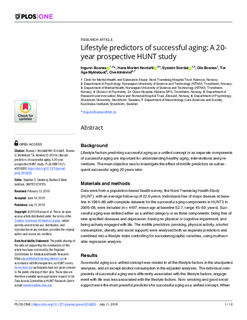| dc.contributor.author | Bosnes, Ingunn | |
| dc.contributor.author | Nordahl, Hans Morten | |
| dc.contributor.author | Stordal, Eystein | |
| dc.contributor.author | Bosnes, Ole | |
| dc.contributor.author | Myklebust, Tor Åge | |
| dc.contributor.author | Almkvist, Ove | |
| dc.date.accessioned | 2020-02-13T09:15:01Z | |
| dc.date.available | 2020-02-13T09:15:01Z | |
| dc.date.created | 2019-09-15T12:17:23Z | |
| dc.date.issued | 2019 | |
| dc.identifier.citation | PLOS ONE. 2019, 14 (7), 1-12. | nb_NO |
| dc.identifier.issn | 1932-6203 | |
| dc.identifier.uri | http://hdl.handle.net/11250/2641470 | |
| dc.description.abstract | Background
Lifestyle factors predicting successful aging as a unified concept or as separate components of successful aging are important for understanding healthy aging, interventions and preventions. The main objective was to investigate the effect of midlife predictors on subsequent successful aging 20 years later.
Materials and methods
Data were from a population-based health survey, the Nord-Trøndelag Health Study (HUNT), with an average follow-up of 22.6 years. Individuals free of major disease at baseline in 1984–86 with complete datasets for the successful aging components in HUNT3 in 2006–08, were included (n = 4497; mean age at baseline 52.7, range 45–59, years). Successful aging was defined either as a unified category or as three components: being free of nine specified diseases and depression, having no physical or cognitive impairment, and being actively engaged with life. The midlife predictors (smoking, physical activity, alcohol consumption, obesity and social support) were analysed both as separate predictors and combined into a lifestyle index controlling for sociodemographic variables, using multivariable regression analysis.
Results
Successful aging as a unified concept was related to all the lifestyle factors in the unadjusted analyses, and all except alcohol consumption in the adjusted analyses. The individual components of successful aging were differently associated with the lifestyle factors; engagement with life was less associated with the lifestyle factors. Non- smoking and good social support were the most powerful predictors for successful aging as a unified concept. When the lifestyle factors were summed into a lifestyle index, there was a trend for more positive lifestyle to be related to higher odds for successful aging.
Conclusions
Lifestyle factors predicted an overall measure of SA, as well as the individual components, more than 20 years later. Modifiable risk factors in midlife, exemplified by social support, may be used for interventions to promote overall health and specific aspects of health in aging. | nb_NO |
| dc.language.iso | eng | nb_NO |
| dc.publisher | Public Library of Science | nb_NO |
| dc.rights | Navngivelse 4.0 Internasjonal | * |
| dc.rights.uri | http://creativecommons.org/licenses/by/4.0/deed.no | * |
| dc.title | Lifestyle predictors of successful aging: A 20-year prospective HUNT study | nb_NO |
| dc.type | Journal article | nb_NO |
| dc.type | Peer reviewed | nb_NO |
| dc.description.version | publishedVersion | nb_NO |
| dc.source.pagenumber | 1-12 | nb_NO |
| dc.source.volume | 14 | nb_NO |
| dc.source.journal | PLOS ONE | nb_NO |
| dc.source.issue | 7 | nb_NO |
| dc.identifier.doi | 10.1371/journal.pone.0219200 | |
| dc.identifier.cristin | 1724783 | |
| dc.description.localcode | © 2019 Bosnes et al. This is an open access article distributed under the terms of the Creative Commons Attribution License, which permits unrestricted use, distribution, and reproduction in any medium, provided the original author and source are credited. | nb_NO |
| cristin.unitcode | 194,67,40,0 | |
| cristin.unitcode | 194,65,35,0 | |
| cristin.unitcode | 1920,22,0,0 | |
| cristin.unitname | Institutt for psykologi | |
| cristin.unitname | Institutt for psykisk helse | |
| cristin.unitname | PH - Nidaros distriktspsykiatriske senter | |
| cristin.ispublished | true | |
| cristin.fulltext | original | |
| cristin.qualitycode | 1 | |

